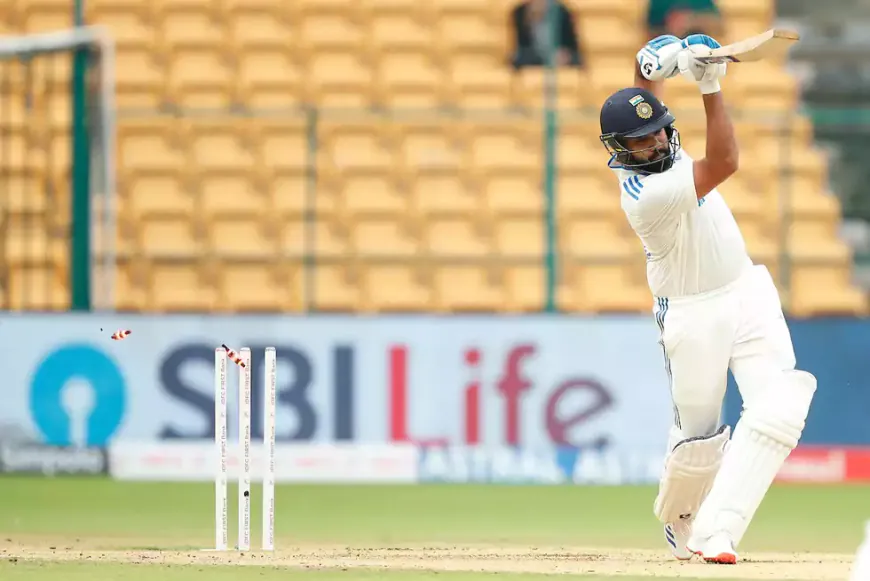India's Disastrous Innings: Records Shattered as They Collapse for 46 Against New Zealand
Additional Record Highlights In terms of Test cricket, India’s 46 all out is now noted as the second-lowest first innings total recorded by any team that chose to bat after winning the toss in a home Test. The lowest such total remains 42, posted by New Zealand against Australia at Wellington in 1946. Furthermore, it is the fourth-lowest first-innings total in Test cricket history for teams that opted to bat first. India has faced difficulties in their batting line-up on several occasions, with this being the third time since 1990 that they lost three or more wickets for 10 runs or fewer at home, and interestingly, all instances have occurred against New Zealand. Previously, they were 7 for 3 in Mohali in 1999 and 2 for 3 against New Zealand in Ahmedabad in 2010.

In a shocking turn of events during the first Test match between India and New Zealand in Bengaluru, the Indian cricket team registered their lowest total in an innings at home, bowled out for just 46 runs. This dismal score eclipsed their previous record of 75 runs against the West Indies in Delhi back in 1987. Furthermore, it stands as the lowest total ever recorded by any team in India, breaking the prior record of 62 runs set by New Zealand during their last tour in 2021 at Wankhede Stadium.
Historical Context of India’s Total
India's abysmal score of 46 now ranks as the third-lowest total in their Test history, trailing only behind their infamous innings of 36 runs against Australia in Adelaide in 2020 and 42 runs against England at Lord's in 1974. Additionally, this score represents India's lowest total against New Zealand, surpassing the previous low of 81 runs achieved in Wellington in 1976. Notably, this 46-run total is also the lowest ever posted by any team facing New Zealand in Test cricket, with the former record being held by Zimbabwe, who managed only 51 runs in Napier in 2012.
Breakdown of India's Lowest Home Scores
Here are the lowest totals recorded by India in home Test matches:
| Total | Overs | Innings | Opponent | Venue | Year |
|---|---|---|---|---|---|
| 46 | 31.2 | 1 | New Zealand | Bengaluru | 2024 |
| 75 | 1 | West Indies | Delhi | 1987 | |
| 76 | 1 | South Africa | Ahmedabad | 2008 | |
| 83 | 4 | England | Chennai | 1977 | |
| 83 | 1 | New Zealand | Mohali | 1999 | |
| 88 | 2 | New Zealand | Brabourne | 1965 | |
| 89 | 2 | New Zealand | Hyderabad | 1969 |
The record of 46 all out also sets a new benchmark for the lowest scores in Asia, overtaking the previous record of 53 runs, which was held by the West Indies against Pakistan in Faisalabad in 1986 and by Pakistan against Australia in Sharjah in 2002.
Additional Record Highlights
In terms of Test cricket, India’s 46 all out is now noted as the second-lowest first innings total recorded by any team that chose to bat after winning the toss in a home Test. The lowest such total remains 42, posted by New Zealand against Australia at Wellington in 1946. Furthermore, it is the fourth-lowest first-innings total in Test cricket history for teams that opted to bat first.
India has faced difficulties in their batting line-up on several occasions, with this being the third time since 1990 that they lost three or more wickets for 10 runs or fewer at home, and interestingly, all instances have occurred against New Zealand. Previously, they were 7 for 3 in Mohali in 1999 and 2 for 3 against New Zealand in Ahmedabad in 2010.
Wicket Fall and Team Performance
The score of 34 at the fall of the sixth wicket is India's sixth-lowest total in Tests, while it also stands as their second-lowest at home, following a mere 27 runs against New Zealand in Hyderabad in 1969.
Notably, five Indian batters failed to score, marking the joint second-most ducks for India in a single innings. This occurrence also marks the third instance overall and the first time in a home Test where four out of the top seven Indian batsmen were dismissed without scoring.
| Ducks | Innings | Opponent | Venue | Year |
|---|---|---|---|---|
| 6 | 1 | England | Manchester | 2014 |
| 6 | 2 | South Africa | Cape Town | 2024 |
| 5 | 3 | Australia | Adelaide | 1948 |
| 5 | 3 | England | Leeds | 1952 |
| 5 | 1 | New Zealand | Mohali | 1999 |
| 5 | 1 | New Zealand | Bengaluru | 2024 |
This instance is only the second time in Test history that five out of the top eight batters were dismissed for ducks, the first being recorded by Australia against England in Manchester in 1888. Additionally, the Indian innings saw 10 wickets fall to pace bowlers, marking only the second time since 2010 that visiting pace bowlers have achieved this against India, with the last occurrence also being by New Zealand in 2012 at the same venue.
Bowling Highlights for New Zealand
Matt Henry’s performance was nothing short of remarkable, claiming 5 wickets for just 15 runs. This marks his first five-wicket haul against India and sets a record for the most economical five-wicket haul by a New Zealand bowler in Test cricket. His figures are now the fourth-best recorded by a New Zealand fast bowler in India, trailing Tim Southee’s 7 for 64 in Bengaluru in 2012, Doin Nash’s 6 for 27 at Mohali in 1999, and Richard Hadlee’s 6 for 49 at Wankhede in 1988.
Henry's achievement also culminated in him reaching the milestone of 100 Test wickets, becoming the joint second-quickest New Zealand player to do so in terms of matches played, a record he shares with Sir Richard Hadlee. Neil Wagner also achieved this feat in just 26 matches.
India's performance in this Test has rewritten records, highlighting the struggles faced by the team in home conditions. The 46 all out reflects deeper issues in their batting lineup, requiring immediate attention as they prepare to face New Zealand in the remaining matches of the series. With bowling performances like Henry's, New Zealand has taken a significant step forward in the Test, and it will be crucial for India to regroup and recover quickly to regain momentum in the series.





















































